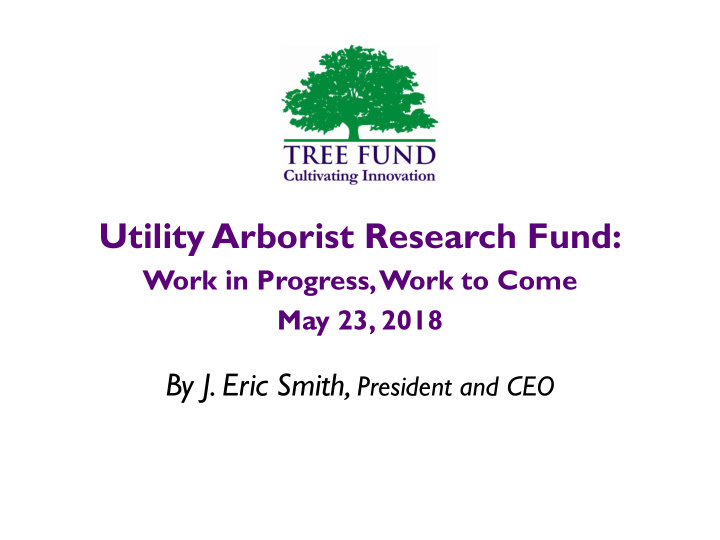



Utility Arborist Research Fund: Work in Progress, Work to Come May 23, 2018 By J. Eric Smith, President and CEO
AN IDEALIZED APPLIED RESEARCH CYCLE Problem Implementation ONE YEAR Research Findings
A REALISTIC APPLIED RESEARCH CYCLE Money Money People People Problem Another Problem Facilities Facilities Another Problem Laws Laws FOREVER . . . Implementation Research No Findings Costly Findings “Competing” “Competing” Implementation Research “Bad” Findings “Competing” Findings
1952: A Problem . . .
1952: A Problem . . . Hunters in the Pocono Mountains reported declining wild game populations in Central Pennsylvania Same hunters also noticed herbicidal applications on utility rights of way in/near their game lands Causation? Correlation? And if so . . . was someone liable?
1952: Research Rabbit habitats established in utility ROWs undergoing herbicidal treatment Dogs broke in and killed the rabbits Finding: Dogs kill rabbits if you let them Problem solved: No.
1953: Research (Take T wo) 3.5 miles of ROW on State Game Lands 33 Six test segments: • Mowing Basal low volume herbicide • Foliar herbicide • Control plots • Initial Public-Private Partnership: Asplundh Tree Expert Company • Penn State University • Pennsylvania Game Commission • • Penelec • DuPont
Bramble and Byrnes (and Johns) Dr. William Bramble, Hyland R. Johns and Dr. Richard Byrnes in 1990.
Bramble and Byrnes (SGL 33) Research continues on original plots 60+ publications by the founders Original game focus expanded • Bird population and nesting ecology • Small mammal population studies • Amphibian and reptile studies • Pollinator studies Continuity of public-private partners: Now Asplundh, Corteva (DowDuPont), PECO, FirstEnergy, PSU
Bramble and Byrnes (SGL 33) Green Lane Research and Demonstration Area added in 1987 Dr. Carolyn Mahan (PSU) leads current work TREE Fund working with PSU and cooperating partners to continue work in years ahead
Eras of IVM (per Christopher A. Nowak) 1890s-1950s: safety, reliability 1960s-1970s: safety, reliability, regulations, environment 1980s-1990s: safety, reliability, regulations, environment, socioeconomics, integration, management systems 2000s-2010s: safety, reliability, regulations, environment, socioeconomics, integration, management systems, sustainability
Utility Arborist Research Fund ➢ Established in 2010 by UAA and TREE Fund ➢ Reached $1.0 million activation level in 2017 ➢ Will award $50,000 per year in perpetuity beginning this year ➢ Funding specifically for utility arboriculture, independent of other research priorities
Why An Endowment? Permanently restricted gifts generate earnings for long-term research Highest long-term return on investment Best way to fund long-term work (e.g. research) on long-lived organisms (e.g. trees) Provides stability to survive down markets
UARF Further Empowers Public-Private Partnerships Businesses, Nonprofits, Municipalities and Academia working together to: Hone evolving definition of IVM, built on scientific • principles, codified in regulations • Manage established test plots, adapting to long-term needs and emergent problems Provide independent validation of findings • • Establish emergent test plots support better understanding of regional variances
UARF Further Empowers Public-Private Partnerships Businesses, Nonprofits, Municipalities and Academia working together to: Educate customers and share-holders • Enhance safety for crews • • Increase profitability – cost analysis indicates so, but quantitative benefit analysis still needs more research
UARF Research Grants ➢ First research report issued in 2015: John Goodfellow’s “Utilizing Data -Driven Methodologies to Manage UVM Programs ” ➢ NEW: $46,000 to Goodfellow for “The Cost - Effectiveness of Integrated Vegetation Management,” continuing to develop business model for industry application, adding analysis of pipelines vs transmission lines (PG&E sponsored)
Example of Public-Private UVM Research Model Integrated Vegetation Management on Powerline Rights-of-Ways: Effects of Vegetation Treatment on Plant Communities and Wildlife Diversity $175,000 grant awarded in December 2016 Partnership between TREE Fund, UAA, Sonoma State, PG&E and SMUD Principal Investigator Christopher Halle will provide summary of work to date and planned
Recommend
More recommend